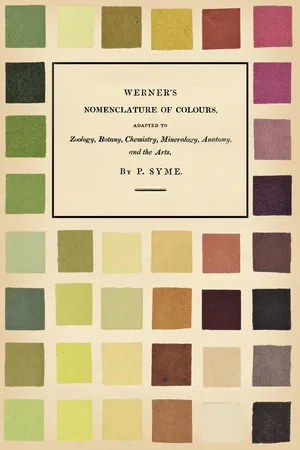![]()
WERNER’S
NOMENCLATURE OF COLOURS.
A NOMENCLATURE of colours, with proper coloured examples of the different tints, as a general standard to refer to in the description of any object, has been long wanted in arts and sciences. It is singular, that a thing so obviously useful, and in the description of objects of natural history and the arts, where colour is an object indispensably necessary, should have been so long overlooked. In describing any object, to specify its colours is always useful; but where colour forms a character, it becomes absolutely necessary. How defective, therefore, must description be when the terms used are ambiguous; and where there is no regular standard to refer to. Description without figure is generally difficult to be comprehended; description and figure are in many instances still defective; but description, figure, and colour combined form the most perfect representation, and are next to seeing the object itself. An object may be described of such a colour by one person, and perhaps mistaken by another for quite a different tint: as we know the names of colours are frequently misapplied; and often one name indiscriminately given to many colours. To remove the present confusion in the names of colours, and establish a standard that may be useful in general science, particularly those branches, viz. Zoology, Botany, Mineralogy, Chemistry, and Morbid Anatomy, is the object of the present attempt.
The author, from his experience and long practice in painting objects which required the most accurate eye to distinguish colours, hopes that he will not be thought altogether unqualified for such an undertaking. He does not pretend indeed that it is his own idea; for, so far as he knows, Werner is entitled to the honour of having suggested it. This great mineralogist, aware of the importance of colours, found it necessary to establish a Nomenclature of his own in his description of minerals, and it is astonishing how correct his eye has been; for the author of the present undertaking went over Werner’s suites of colours, being assisted by Professor Jameson, who was so good as arrange specimens of the suites of minerals mentioned by Werner, as examples of his Nomenclature of Colours. He copied the colours of these minerals, and found the component parts of each tint, as mentioned by Werner, uncommonly correct. Werner’s suites of colours extend to seventy-nine tints. Though these may answer for the description of most minerals, they would be found defective when applied to general science: the number therefore is extended to one hundred and ten, comprehending the most common colours or tints that appear in nature. These may be called standard colours; and if the terms pale, deep, dark, bright, and dull, be applied to any of the standard colours, suppose crimson, or the same colour tinged lightly with other colours, suppose grey, or black, or brown, and applied in this manner:
If all the standard colours are applied in this manner, or reversed, as grey tinged with crimson, &c. the tints may be multiplied to upwards of thirty thousand, and yet vary very little from the standard colours with which they are combined. The suites of colours are accompanied with examples in, or references to, the Animal, Vegetable, and Mineral Kingdoms, as far as the author has been able to fill them up, annexed to each tint, so as to render the whole as complete as possible. Werner, in his suites of colours, has left out the terms Purple and Orange, and gi...


